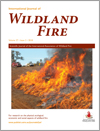International Journal of Wildland Fire
Volume 27
Number 3 2018
Locations of past fatal firefighter burnovers coupled with a machine-learning algorithm were used to identify and characterise the environmental variables that contribute to the likelihood of a fatal burnover in Southern California. Steep, south-west-oriented slopes located in canyons that have a shrub fuel type were found to be the most dangerous locations for firefighters.
Some large wildfires are very dangerous for firefighters. These fires grow rapidly and behave erratically, sometimes entrapping the responders. We analyse reports of past fires and determine the weather conditions that are conducive to those dangerous fires in the French Mediterranean Basin.
We projected changes in future burning rates in Canada using several statistical models. The consensus showed a strong increase in burning rates, but large variations among single models, variations that were significantly higher than the one related to climate scenarios.
By area, 70% of US prescribed burns take place in the Southeast, where treatment objectives are wide ranging and accomplishing them depends on finding specific weather conditions for the effective application of fire. Our findings offer a tool for understanding and predicting the climatological and interannual variability of this weather window.
The effect of aspect and vegetation structure on the fine fuel moisture content of different fuel strata was investigated. The effect of the percentage of fuel available for burning and when top litter moisture content fell into categories associated with severe fire behaviour and fire management planning was further discussed.
This study evaluated water-quality data from 159 fires in 153 burned watersheds to determine if there is a common water-quality response after forest fire. Findings from this study show a significant increase in nutrient concentrations and flux (different forms of nitrogen and phosphorus), major-ion flux and elevated suspended metal concentrations are the most common responses after fire. Concentrations of dissolved matter tended to decrease after fire, partly due to increased volume of discharge after fires, whereas particulate matter increased in concentration, likely due to recurrent increased erosion. Elevated loading rates of these constituents persist for up to 5 years or more after fire.




